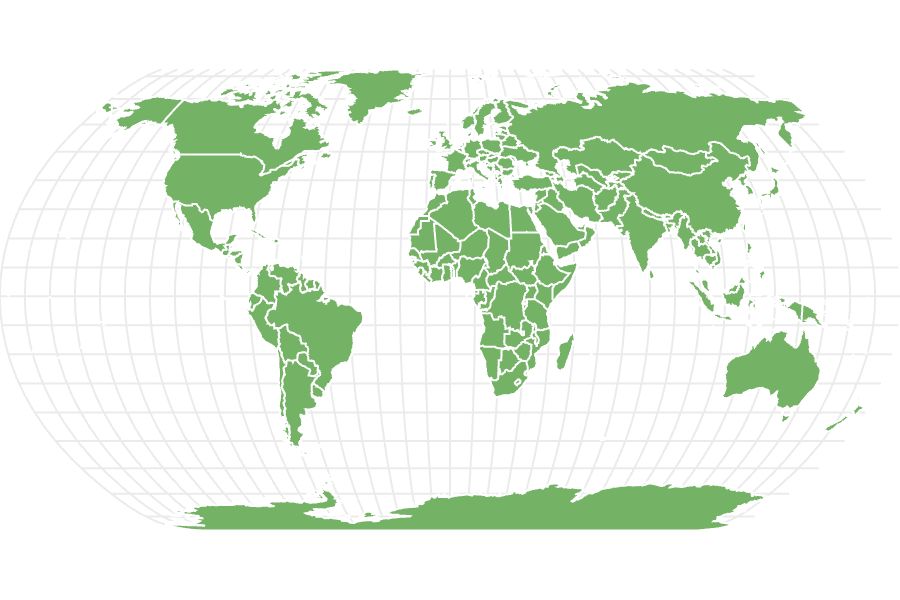Chinook Salmon
Oncorhynchus tshawytscha
The Chinook salmon undertakes a long migration for the spawning season
Advertisement
Chinook Salmon Scientific Classification
- Kingdom
- Animalia
- Phylum
- Chordata
- Class
- Actinopterygii
- Order
- Salmoniformes
- Family
- Salmonidae
- Genus
- Oncorhynchus
- Scientific Name
- Oncorhynchus tshawytscha
Read our Complete Guide to Classification of Animals.
Chinook Salmon Conservation Status
Chinook Salmon Facts
- Prey
- Crustaceans, insects, and other fish
- Group Behavior
- School
- Fun Fact
- The Chinook salmon undertakes a long migration for the spawning season
- Estimated Population Size
- Millions
- Biggest Threat
- Over fishing, habitat loss, and pollution
- Most Distinctive Feature
- The silvery scales
- Other Name(s)
- King salmon, spring salmon, blackmouth, Quinnat salmon, and more
- Gestation Period
- 3-5 months
- Habitat
- Northern Pacific
- Predators
- Sharks, orcas, sea lions, birds, and larger fish
- Diet
- Carnivore
- Type
- Ray-finned fish
- Common Name
- Chinook salmon
- Number Of Species
- 1
View all of the Chinook Salmon images!

The Chinook salmon is the largest species of salmon in the Pacific; this is why they’re also called the king salmon.
The Chinook salmon is among the most important fish in its region. It is a linchpin of the local ecosystem. Each year these salmon make an annual migration inland for the spawning season. They are concentrated in such great numbers in the streams that people and other hungry animals gather to catch them. However, because of the popularity of their meat, there is evidence that the stock of Chinook is being depleted in some areas of the world.
3 Chinook Salmon Facts
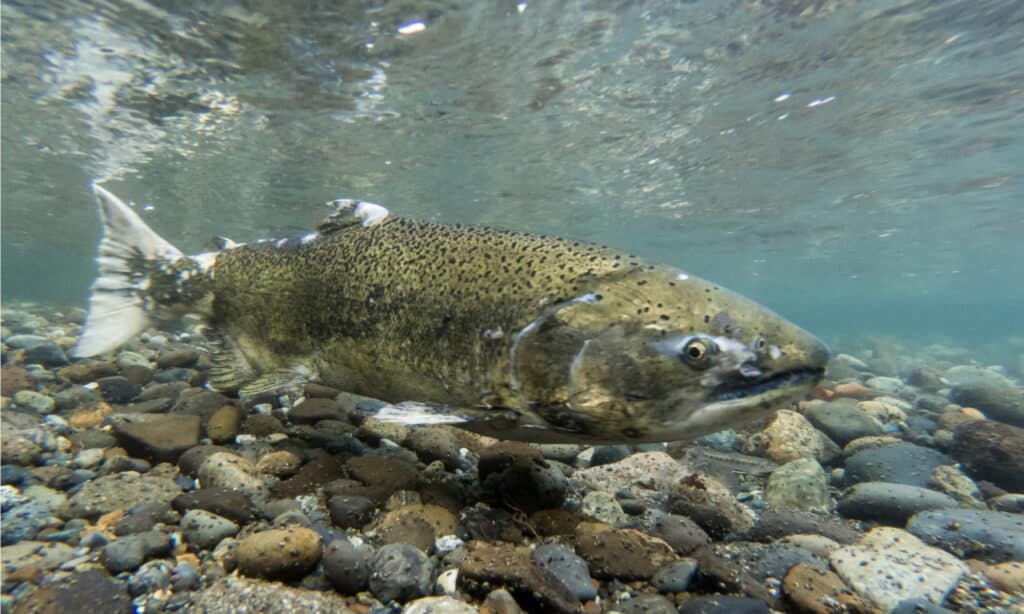
Chinook salmon has a long, tapered body with a blue-green back, a silver sheen on their sides, and a white belly.
©Kevin Cass/Shutterstock.com
- Chinook is the name of the indigenous peoples of the Pacific Northwest who speak the Chinookan language. Salmon is among the most important elements of their diet.
- When the Chinook dies, the carcass provides a valuable source of energy and nutrients for other organisms. Studies have shown that their deaths improve the survival rates of newly hatched salmon.
- In some areas of the Pacific Northwest, the annual salmon run has traditionally been known as June hogs.
Evolution and Origins
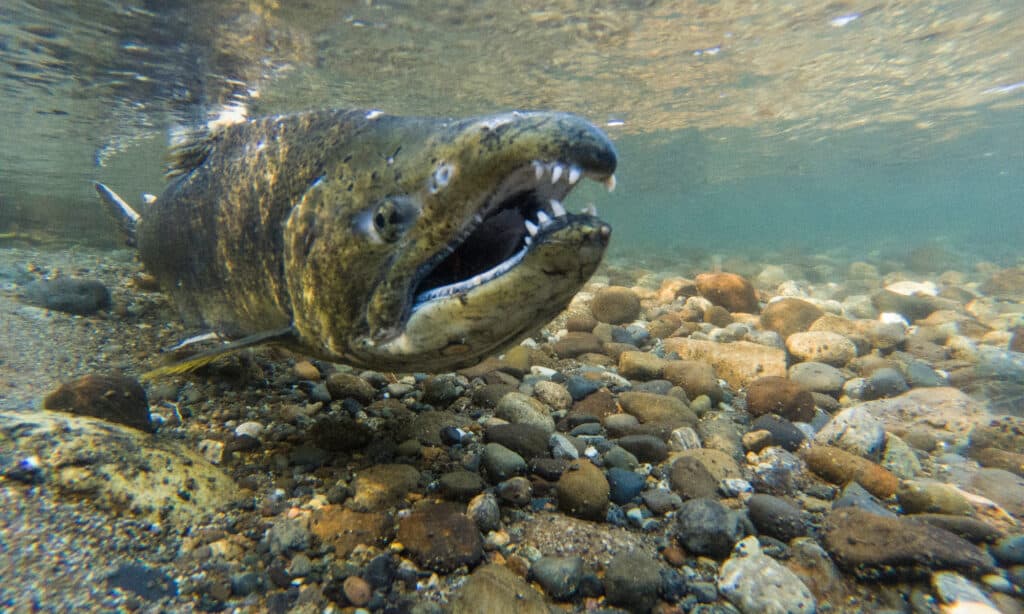
The five types of salmon in Alaska – chinook, coho, sockeye, chum, and pink.
©Kevin Cass/Shutterstock.com
The five types of salmon in Alaska – chinook, coho, sockeye, chum, and pink – come from the same family as steelhead, also known as rainbow trout. These salmon have been here for a really long time, showing up about 4 to 6 million years ago.
King salmon (Oncorhynchus tschawytscha) holds the title of being the biggest among the Pacific salmon. They originally come from the northwest coast of North America and Northeast Asia. In the late 19th century, they were brought to New Zealand from northern California as a sport fish.
Further, around 5 million years ago, during the end of the Miocene period, the original Oncorhynchus fish in North America split into two groups. One group eventually became the Pacific salmon, while the other group evolved into the Western trout.
Classification and Scientific Name
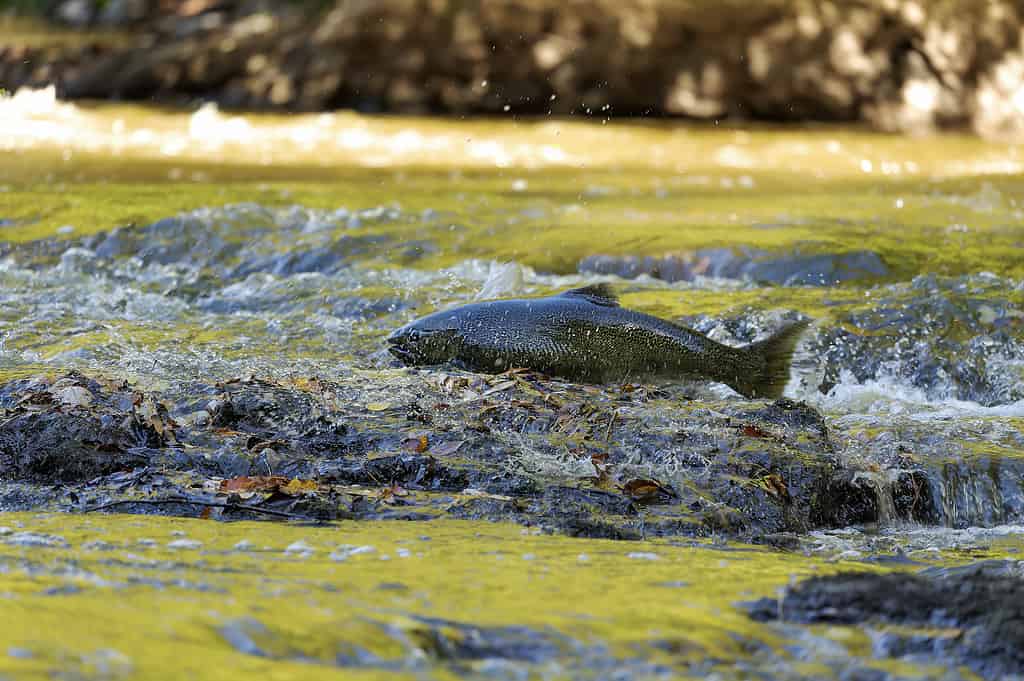
The scientific name for the Chinook salmon is
Oncorhynchus tshawytscha.
©iStock.com/Karel Bock
The scientific name for the Chinook salmon is Oncorhynchus tshawytscha. The genus name Oncorhynchus is derived from two Greek terms: onkos, meaning lump or bend, and rhunkhos, meaning snout. This refers to the hooked snout that the male will grow in the reproductive season. Tshawytscha is the Russian name for this species in the far eastern part of the country. The Chinook is closely related to the sockeye salmon, rainbow trout, and pink salmon.
Appearance
For most of their adult lives, the Chinook salmon have a long, tapered body with a blue-green back, a silver sheen on their sides, and a white belly. This is accompanied by black spots on the upper half of the body and the lobes of the tail fin. Another black streak along the gum line gives them the alternate name of blackmouth.
In preparation for the spawning season, the Chinook suddenly changes color to an olive-brown, red, or purple-hued body, and the males develop the hook on their upper jaw. The females, by contrast, can be identified by their blunt nose and larger mid-section.
The Chinook is among the largest of all salmon. They typically measure about 3 feet long and 30 pounds in weight, but the world record was nearly 5 feet long and weighed almost 130 pounds.
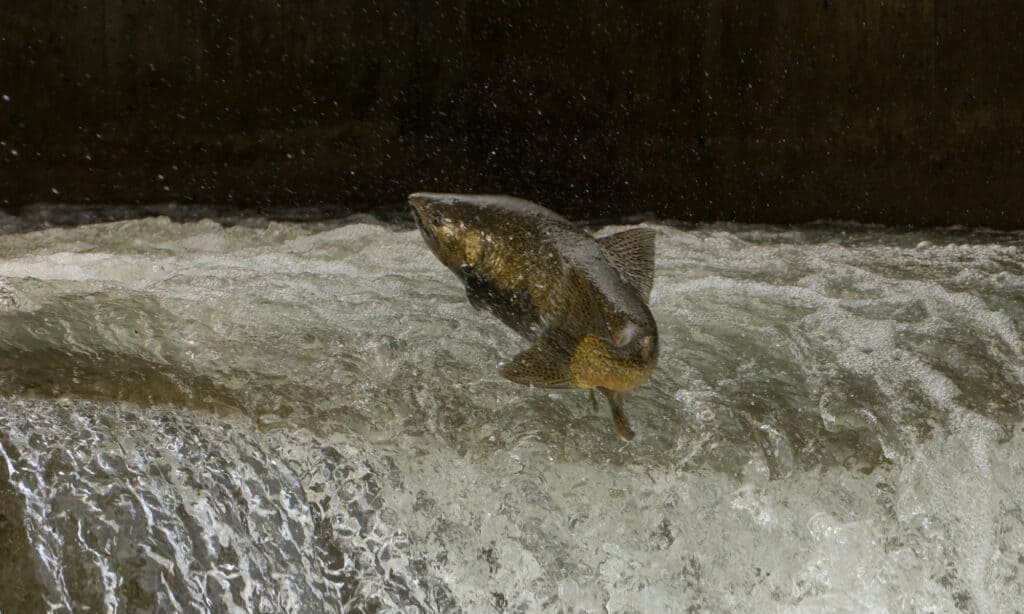
©Evan Linnell/Shutterstock.com
Distribution, Population, and Habitat
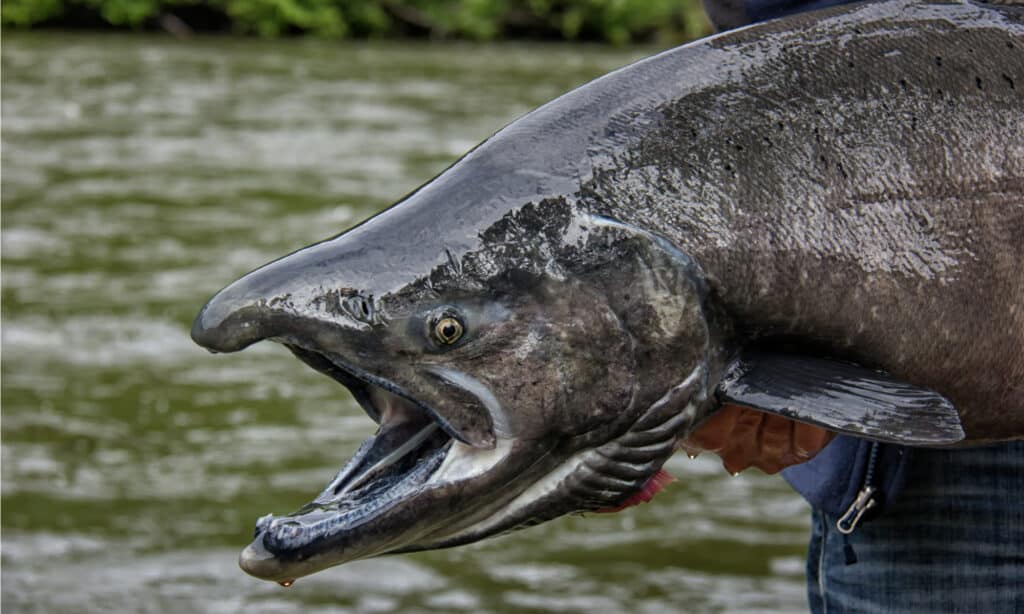
The Chinook Salmon is of Least Concern and not considered endangered.
©Martin Rudlof Photography/Shutterstock.com
The Chinook salmon is native to the Northern Pacific region, from California to Alaska in the east and Japan and Russia in the west. This species has also been introduced to New Zealand, the Great Lakes region, and Patagonia in South America. They spend a great deal of their time at the bottom of the seafloor, hiding among grass and seaweed. Cool, clean water with plenty of oxygen is usually required for optimal health.
According to the IUCN Red List, the Chinook salmon is a species of least concern. However, numbers can vary dramatically by region. Although many populations appear to be increasing, two populations of Chinook were endangered and seven more were threatened as of 2020.
The biggest problems appear to be climate change, overfishing, the loss of habitat from dam construction and urban development, and polluted water from agriculture and logging. These stressed or endangered stocks are subject to intense regulation by the NOAA (National Oceanic and Atmospheric Administration). They are also protected by the Endangered Species Act.
Predators and Prey
The Chinook salmon are primarily carnivorous in nature. They feed near the bottom of the seafloor, spending years gathering enough strength to return back upstream and spawn.
What eats the Chinook salmon?
The adult Chinook is preyed upon by killer whales, sea lions, and sharks in the wild. Juveniles are also prey for birds and other fish such as mackerel. Their colors provide a degree of camouflage against the seagrass in which they often reside.
What does the Chinook salmon eat?
Adult Chinook primarily feeds on other fish. Juvenile Chinook feeds on insects and crustaceans.
Reproduction and Lifespan
The spawning season usually takes place each year between September and December. The annual migration upstream is an arduous journey that requires a great deal of strength. Upon reaching their spawning location inland, the Chinook will dig out a gravel nest called a redd at the bottom of the stream. The female will guard her nest for up to 25 days, but the eggs can take three to five months before fully hatching.
The fry will remain in the freshwater for the next 12 to 18 months as they feed and grow before returning to the ocean. The technical term for a species that migrates between saltwater oceans and freshwater rivers or streams is anadromous. The young Chinook will spend several years in the ocean growing as large as they can. They will reach sexual maturity at any point between two and seven years old. After spawning once, the Chinook die almost immediately.
Fishing and Cooking
The Chinook salmon is among the most common commercial fish in the United States. Stocks are carefully regulated and managed to ensure that they are exploited in a sustainable manner. Thanks to the high-fat content, Chinook meat is said to have a rich taste.
A single serving has around 350 calories and about 20 grams of fat. Chinook is fairly easy to roast, grill, broil, or saute. They can be served with seasoned butter, pesto, salsa, romesco, vinaigrettes, and other sauces; potatoes, rice, and lemon are also popular choices to serve alongside the salmon meat.
View all 235 animals that start with CChinook Salmon FAQs (Frequently Asked Questions)
Where do Chinook salmon live?
The Chinook live in shallow water throughout the Northern Pacific.
What do Chinook salmon eat?
Adult Chinook typically consumes other fish.
Is Chinook salmon the same as king salmon?
Yes, they are both the name for the same species. The Chinook are called the king salmon on account of their massive size. The world record for a Chinook catch was about 126 pounds. This world record was established in 1949 near Petersburg, Alaska.
Is Chinook salmon good eating?
Yes, the Chinook meat is said to have the best taste among all of the salmon. Although a little high in calories, they have excellent nutritional content.
What is unique about Chinook salmon?
The Chinook are exceptionally large and spend extra time in the ocean compared to other salmon.
How many Chinook salmon are left in the world?
Total population numbers are unknown, but the total size of the harvest is more than a million each year.
Thank you for reading! Have some feedback for us? Contact the AZ Animals editorial team.
Sources
- NOAA Fisheries, Available here: https://www.fisheries.noaa.gov/species/chinook-salmon
- New York Times, Available here: https://cooking.nytimes.com/guides/19-how-to-cook-salmon
- Nutrition Data, Available here: https://nutritiondata.self.com/facts/finfish-and-shellfish-products/4232/2

